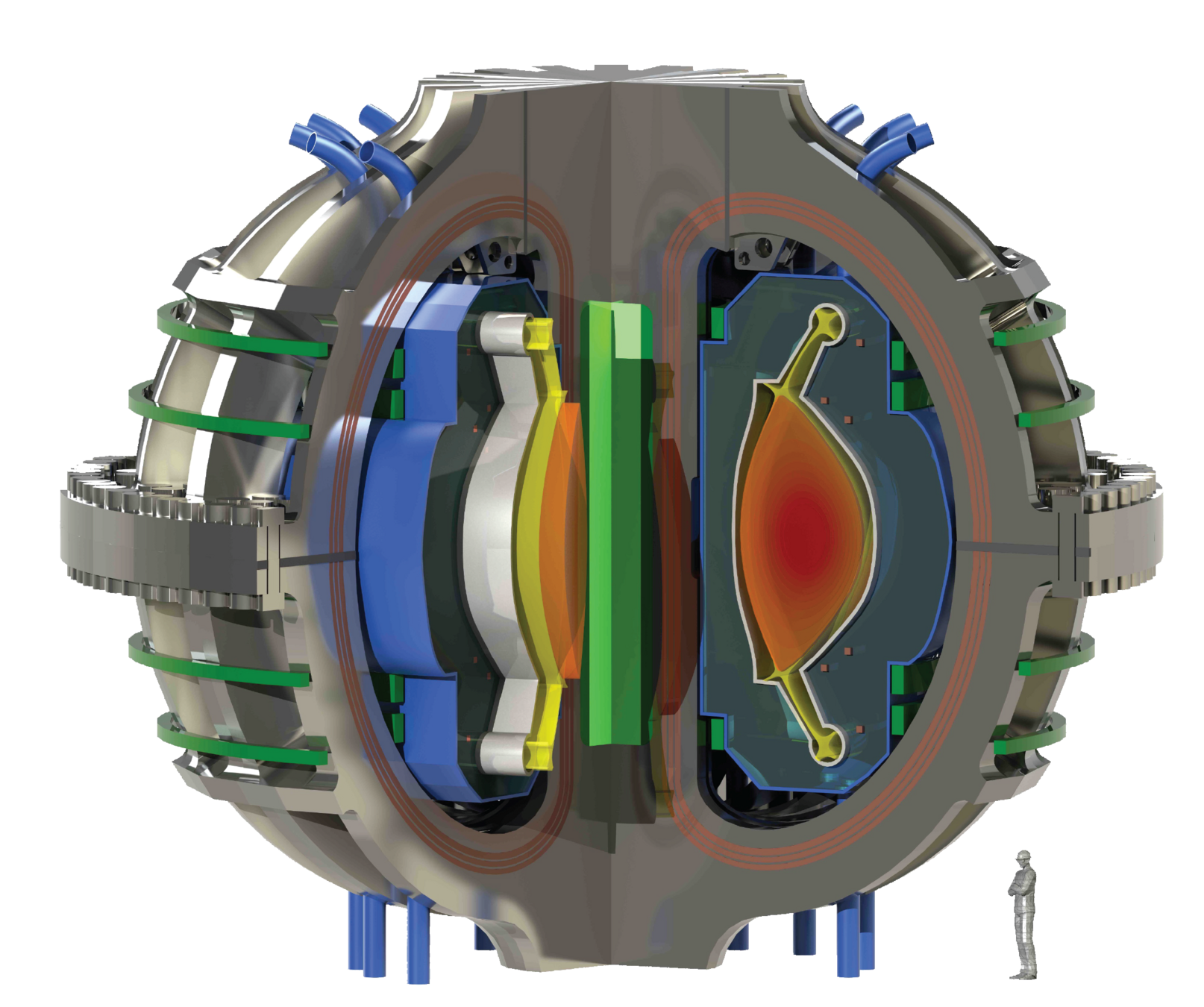Challenges Related to Tritium Transport in Fusion Reactors:
from component to system level


Remi Delaporte-Mathurin
Plasma Science and Fusion Center, MIT, USA
MATERIAL

Half-life: 12 years
☢
Consumption of a 1 GWth fusion reactor (1 year)
50 kg
+ radiological safety & regulatory issues
The breeding blanket

The breeding blanket is only one component of the fuel cycle

Component
Material
What is the required TBR? Startup tritium inventory?
What are the minimum dimensions of the extractor?
How much T is retained in the plasma facing materials?
What is the T concentration at the blanket outlet?
What is the diffusivity of EUROFER?
Trapping properties of tungsten?
Permeation reduction factor of coating X?
System
Multi-scale tritium design
Design issues propagate
Challenge #1: the residence time method is not predictive
Challenge #3: Experiments for Property Measurements Are Not Standardised
Challenge #4: Data on Transport Properties is Scarce and Variable
Challenge #2: Component-Level Testing Remains Limited
Component
Material
System
Outline
Component
Material
System
Challenge #1: the residence time method is not predictive
Context: system fuel cycle modelling and the residence time method
Residence time
For each component \(i\)

Goal: to model tritium mass fluxes between components
Illustration with a simple fuel cycle model
Burns tritium
Breeds tritium (TBR)
Tritium Extraction System
Breeding Blanket
Plasma
Storage
neutrons
Startup inventory
Tritium Extraction System
Breeding Blanket
Plasma
Storage
Limitations
- How to estimate the residence time?
- What if there are several phases in the blanket (eg. LiPb and coolants)?
- Great simplifications need to be made for permanent trapping
Current situation
-
System-level tritium models often use fixed residence times for each subsystem.
-
Approach is empirical and lacks connection to material physics.
Risks & implications
Path forward
-
Large uncertainties and increased safety and performance risks.
-
Inconsistent assumptions across organisations → poor comparability.
-
Weak technical basis for regulatory review.
Move towards physics-informed component-level models
Challenge #1: the residence time method is not predictive
Path forward
Move towards physics-informed component-level models
Challenge #1: the residence time method is not predictive


Other physics-informed models:
- Simpler 1D models
- Surrogate models
- Empirical experimental laws
- ...
FESTIM model of an ARC's breeding blanket
COMSOL model of a bubble column T extractor
Teng Wang et al 2025 J. Phys.: Conf. Ser. 3011 012054
Dark et al, Tritium 2025, 10.13140/RG.2.2.28729.84321
Component
Material
System
Challenge #2: Component-Level Testing is limited
Current situation
-
only few integrated tritium breeding tests + extraction tests exist under "relevant" combined conditions
-
other hydrogen experiments are focused on coupon tests
Risks & implications
Path forward
-
Large uncertainty in system-level tritium recovery predictions.
-
Missing data for code validation and licensing.
- More component level experiments such as LIBRA
- A dedicated fuel cycle component test facility
Challenge #2: Component-Level Testing is limited
Component
Material
System
Challenge #3: Property Measurements are not Standardised
Context: hydrogen transport properties
Governing equations for H transport
Material properties
- Properties can be obtained experimentally (gas driven permeation, plasma-driven permeation, absorption, thermo-desorption, electro-permeation...)
- Simple in principle, complex in practice.

MIT's SHIELD permeation rig
Current situation
-
No standards for experiments (except electro-permeation ASTM)
-
No standard way of disseminating results (units, dimensions...): see Challenge #4
-
Hard to quantify tritium retention/trapping
-
Few inter-laboratory comparisons (round Robins).
Risks & implications
Path forward
-
Poor reproducibility and large data scatter.
-
Difficult to identify reliable reference values.
-
Increased risk for dimensioning of components.
Develop standardised experiments & protocols
for GDP, TDS, PDP...
Challenge #3: Property Measurements are not standardised
Component
Material
System
Challenge #4:
Data on transport properties is scarce and variable
Context: hydrogen transport properties (next)


Tungsten's diffusivity
LiPb solubility
- Different tungsten grades?
- Different setups?
- Isotopic effect?
- Influence of trapping? effective diffusivity?
- 4 orders of magnitude variation!
- Composition?
- Difficulties measuring liquids?
- Mistakes in unit conversion?
Source: HTM database v0.17
Current situation
-
diffusivity, solubility, and trapping parameters vary by up to orders of magnitude in literature.
-
several sources of truth (lit. reviews) and no unified database
Risks & implications
Path forward
-
unreliable component-level simulations
- poor reproducibility of model predictions.
Establish a large hydrogen transport properties database
Challenge #4: Data on Tritium Properties is Scarce and Variable
Path forward
Establish a large hydrogen transport properties database
Challenge #4: Data on Tritium Properties is Scarce and Variable
Citable and Persistent
-
Each dataset has a DOI and version number.
-
Enables reproducibility and traceable references in reports, models, and standards.
Peer-Reviewed and Curated
-
Data vetted by subject-matter experts before inclusion.
-
Documented acceptance criteria (e.g. residuals, experimental validation quality).
Standardised Format
-
Machine-readable (e.g. JSON, CSV, or YAML) and interoperable with modelling codes
-
Consistent units, naming conventions, and metadata schema (e.g. composition, phase, microstructure).
Version-Controlled, Openly Licensed, and Transparent
-
Public Git repository or data platform (e.g. Zenodo, GitHub).
-
Each update logged with changelogs and clear licence (CC-BY or similar).
-
Extensible.
-
Full provenance of every data point
Needs to be:

The HTM database
✅Citable and Persistent
✅Version-Controlled, Openly Licensed, and Transparent
✅Peer-Reviewed and Curated
✅Standardised Format
✅Compatible with modelling workflows

But lacks one crucial ingredient: incentives from research programmes
HTM dashboard
Component
Material
System
Bonus Challenge:
Open-science and transparency
Data availability and open science
"dAtA WiLl bE aVaiLabLe uPoN rEqUeSt"
Current situation
-
Many modelling tools and datasets are closed-source
-
Lack of transparency when disseminating results.
Risks & implications
Path forward
-
Limited reproducibility
-
Duplication of effort
-
Slow progress toward standardisation and regulatory trust.
- Support open-source initiatives and provide incentives to open-science
- Provide clear guidelines on how to do open-science
Challenge #5: Open-Science and Transparency
Unpopular opinion: open-science is more than publishing a paper at the end of a project

https://ossfe.org/
Thank you!
Any question?
✉️ remidm@mit.edu

Challenges Related to Tritium Transport in Fusion Reactors: From Component to System Level
By Remi Delaporte-Mathurin
Challenges Related to Tritium Transport in Fusion Reactors: From Component to System Level
- 45



